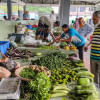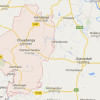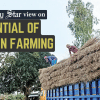Reducing methane emissions in our agriculture

A few days before COP28, Ajay Banga, president of the World Bank, was featured in a talk show where he declared that the Bank would fund efforts to cut down methane emissions in agriculture by tweaking farming practices in rice-growing countries. He specifically mentioned the widespread method of irrigation flooding and the resultant methane emissions in these countries: "Methane is one rare, clear area where we know there are low-cost remedies, effective and simple solutions that can be replicated and scaled," Banga said.
Unfortunately, field trials carried out in Bangladesh and other countries—including China, the world's largest producer of rice—show that economic incentives are a significant hindrance and policy measures need to be calibrated to nudge small-scale farmers to adopt the alternate wetting and drying (AWD) technology that might be available.
It has been known for decades that submerged paddy-growing fields are a major source of methane gas. Since its first trials in 2005, the management practice of AWD emerged, encompassing the ability to flood and drain rice fields in a timely manner, and it has been promoted and evaluated in Bangladesh. However, it is not clear whether the goal to reduce methane emissions to zero by 2030 can be achieved with AWD alone. Also, the field experiments conducted in Bangladesh show that AWD may not be very popular with farmers. In addition, the implementation of AWD is conditional upon constant monitoring and a tech-savvy group of farmers, which is difficult to find as educated youth are moving away from rural areas.
Nonetheless, Banga's promise to fund innovative irrigation and drainage projects, made in the context of COP28's pledge to reduce methane emissions to "near zero" by 2030, has generated renewed interest in AWD irrigation technology.
Bangladesh is the world's third-largest producer of rice—producing up to three rice crops in a single year—with an output of 38.3 million tonnes in 2022/23. Our methane intensity is lower than that of the two largest producers, China and India. Regardless, we are committed to lowering it further.
Bangladesh's goal as a signatory to the Paris Agreement, as enunciated in the Nationally Determined Contributions (NDC), is to reduce methane emissions from AFOLU (agriculture, forestry and other land use) significantly.
Incidentally, Bangladesh also has the seventh-highest livestock density in the world. As per a study by the International Maize and Wheat Improvement Center, "...the greenhouse gas output of agriculture in Bangladesh was 76.79 million metric tons of carbon dioxide equivalent (Mt CO2e) in 2014-15… At the going rate, total agricultural emission from Bangladesh are expected to reach 86.87 Mt CO2e by 2030, and 100.44 Mt CO2e by 2050."
Bangladesh is aiming to take mitigation actions to reduce methane emission by "Upscaling Alternate Wetting and Drying (AWD) in dry season rice field on 50,000 hectares of crop land," per the NDC.
The best-established method of cutting methane from rice farming is to shift away from traditional flooded-field methods. The System of Rice Intensification (SRI), which originated in Madagascar in 1981, does this through the use of shallow and intermittent irrigation or alternate wetting and drying (AWD). Research has found these techniques can reduce methane emissions from rice growing by 22–64 percent. Initially evaluated as a water-saving practice in the Philippines in 2002, AWD was first tried in Bangladesh in 2005 by the Bangladesh Rice Research Institute (BRRI).
Instead of keeping their fields continuously flooded, farmers should drain rice paddies two to three times during the growing season. This limits the amount of methane that is produced, does not compromise yield, and saves money for farmers as it requires one-third less water.
Globally, flooded rice cultivation is responsible for approximately 22 percent of all agriculturally related methane (CH4) emissions and 11 percent of anthropogenic CH4 emissions. Production of in rice systems is primarily the result of fermentation of soil organic matter under flooded anaerobic (waterlogged) conditions.
Experiments in China show AWD can be carried out under two different regimes: 1) with the application of the internet of things (IoT), and 2) through manual monitoring and drainage. The assessments also show that the larger economies of scale would make the IoT investment highly profitable. But for smallholder farmers, low-cost manual AWD is a better alternative.
A second problem that rice farmers face is the migration of the more educated and younger generation to urban areas for higher-paying, non-farm jobs. "Alternate wetting and drying (AWD) irrigation technique is an intellectual irrigation schedule management system for rice cultivation," according to Prof Rahedul Islam of Pabna University of Science and Technology. The studies conducted by Islam reveal several barriers to AWD irrigation systems, including water pricing practices, small farm sizes, and adverse incentives or market failure.
The profitability of AWD technology depends on whether farmers face volumetric (marginal) prices, where irrigation cost will depend on usage. A Tufts University study, with randomised controlled trials in 544 villages of rural Bangladesh, shows that AWD only leads to measurable water savings in villages where farmers pay a volumetric price for water and not in villages where water prices are set by the acre.
The World Bank must bear in mind that project funding must be fine-tuned for local conditions. Experiments suggest that there may be a fundamental market failure that explains why farmers do not value water-saving technology. Plus, farmers are confused about when they should and shouldn't flood their fields. Finally, in Bangladesh, several studies show that use of smart technology helps. As an example, if you retrofit tubewells to work with debit cards and create infrastructure such that debit cards can be easily recharged, that will be a positive step. Behavioural economics studies across the spectrum show that influencers can nudge to influence and change the decision-making behaviour of small farmers to adopt water-saving and other climate-friendly practices.
Dr Abdullah Shibli is an economist and works for Change Healthcare, Inc, an information technology company. He also serves as senior research fellow at the US-based International Sustainable Development Institute (ISDI).
Views expressed in this article are the author's own.
Follow The Daily Star Opinion on Facebook for the latest opinions, commentaries and analyses by experts and professionals. To contribute your article or letter to The Daily Star Opinion, see our guidelines for submission.

 For all latest news, follow The Daily Star's Google News channel.
For all latest news, follow The Daily Star's Google News channel. 








Comments